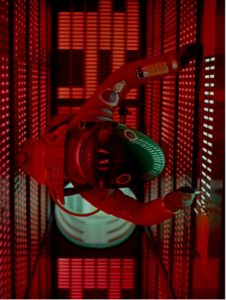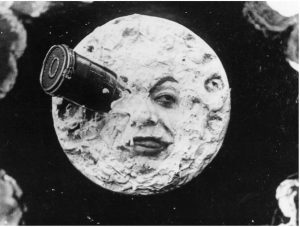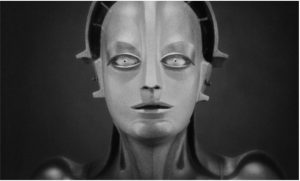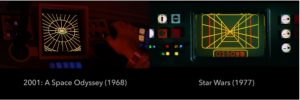The scene I am analysing is linear and anti-realist, as HAL themself and every aspect of the sci-fi mise-en-scene does not exist in our world. This part of the story, like the story as a whole, is told using limited dialogue and visual cues.
The sci-fi genre is made evident through the codes and conventions of the film. These codes include the several high-resolution futuristic sans serif typefaces, such as Futura, a timeless design language, with elements such as the glowing (often oblong circle) shapes in HAL’s processor core and the large hangar in Space Station 5 (both later used extensively in the design of spacecraft in Star Wars) and setting, as well as powerful iconography, such as the unnaturally perfect form of the monolith, the effects of weightlessness, large space stations refuelling smaller vessels and rotating wheel space stations. Conventions, many of which were spawned from the film itself, include problems with suspended animation, the incompatibility of artificial and human intelligence and a classically inspired score.

Dr. David Bowman inside HAL’s processor core. The glowing red oblong circles are shown in the background.
The film does not cater to the audience’s expectation of its genre: it not only actively subverts them but requires the audience to change their entire perception of the genre. Sci-fi movies, with a few notable exceptions such as Le Voyage dans la Lune (A Trip to the Moon, 1902) and Metropolis (1927), before 1968, were very much viewed as novelty pulp fiction and not a true art form. Though the stories could be complex, the narratives were often extremely simplistic. 2001 inverted this, with a purposefully barebones story and highly developed narrative, told predominately through visual concepts; show, don’t tell, or, in Kubrick’s own words, “basically a visual, nonverbal experience hit[ting] the viewer at an inner level of consciousness”. This elevated literary sci-fi into the mainstream.


Le Voyage dans la Lune (A Trip to the Moon, 1902) pictured left
Metropolis (1927) pictured right
2001: A Space Odyssey bears some shocking visual similarities to Star Wars (later, Star Wars: Episode IV – A New Hope) (1977, dir. George Lucas): its use of a classical-inspired score, its scale, the resemblance of the Class-6 escape pod R2-D2 overrides to 2001’s Aries Ib Lunar Lander – with its face-like appearance, the pod’s very similar trajectory, the aforementioned hanger with glowing light shapes, the near-identical shot of Yavin 4, the similar design of the Tantive IV to the Discovery One and the similar targeting (Star Wars) and landing (2001) computers, to name but a few.




![Film Analysis (2001: A Space Odyssey | Goodfellas) [Part 3]](https://joestudios.co.uk/wp-content/uploads/2021/04/DSCF0361-Optimised.jpg)